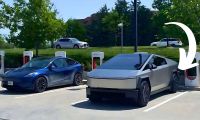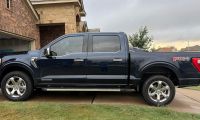As the automotive fleet continues its shift from internal combustion (IC) propulsion to electric, some skeptics have raised the question of battery performance in the cold. And, there are other questions, too. They include:
Performance Questions Needed Answers
- How does an electric vehicle (EV), car, or truck performance?
- Is there any effect on the type of traction in an EV?
- How does an electric handle the almost instant power availability?
- How does an EV handle different surfaces, ice, and snow?
- How does an EV handle generally slippery surfaces?
As noted, there have been many unanswered questions about EV (car or truck) performance in the extreme cold. Let's face it, about half of the country is in 0-Fahrenheit or below territory for periods in the winter. Indeed, this winter temps in the northern half of the country dipped far below 0, and many wondered just how battery-powered vehicles would perform.
One question that has been answered is whether the F-150 Lighting can provide power if the grid goes down in a storm. The answer is yes, for several days.
It’s A Simple Question To Answer
Why would they wonder? It is simple. Suppose you were to take a new, fully charged battery in an IC-powered vehicle and watch the temp fall far below 0. And, if you were to graph out the performance of that battery, you would find that even new, fully charged batteries ran into a half-power point at roughly 20 to 25 below. The curve, below this point, begins to fall even more quickly to the point where unless you have a battery heater or booster, there's very little power left to crank things over.
Even though EVs will perform in the areas where battery performance might fall off, let's face it. Do you wonder how they would perform? Indeed, Ford's EV engineering team had the same type of concerns – though their concerns were more on a par with how an EV handled –so they traveled to Alaska to find out.
This winter, Ford engineers spent two weeks in the heart of Alaska in minus 30-degree temperatures to continue fine-tuning the F-150 Lightning pickup's performance on low-traction surfaces like snow and ice and in extreme cold to give customers maximum confidence. The team answered the questions about handling and traction and found out that EV battery tech handles the extreme cold with little problem.
"Alaska provides us the extremely cold temperatures, snow, and ice-covered surfaces that we need to push the F-150 Lightning in this type of testing, which is really focused on dialing in how the truck delivers its power to the ground on slippery surfaces," said Cameron Dillon, F-150 Lightning powertrain engineer. "Customers may not regularly see minus 30-degree mornings like we are seeing here, but they will see winter cold, snowy, and icy roads, and they should feel confident their F-150 Lightning is ready for all of it."
Cold Weather Testing Called Low-Mu
Formally called low-mu testing, this type of powertrain evaluation looks at how the all-electric powertrain adjusts power delivery to the wheels on low-traction surfaces – usually snow and ice in frigid temperatures. And what better place to test than at a restricted military base in Alaska?
Ford engineers drove a fleet of six F-150 Lightning pre-production units on various wintery surfaces such as loose snow, packed-groomed snow, complete ice, half ice-half concrete surfaces, and more in the freezing temperatures. The F-150 Lightning pickup can sense wheel slip and adjust power to the wheels within milliseconds, benefiting from the quick responses of the all-electric powertrain.
"F-150 Lightning in the snow is a very different ballgame compared to gas vehicles," said Nick Harris, F-150 Lightning powertrain engineer. "The responses are extremely quick, and the dual motors make it as if you have two engines pumping out power in one vehicle. A lot of our work is to coordinate the two motors to work together to deliver torque to the ground best so that customers who drive in the snow and ice ultimately feel very confident."
F-150 Lightning offers stability and confidence in slippery conditions thanks to benefits attributed to its all-electric powertrain, and its functionality:
Engineers Had Several Questions
- Standard dual motors front and rear
- Standard always-on 4x4
- Quick torque delivery
- Standard electronic-locking rear differential
- Selectable drive modes
- Low center of gravity for even more confident handling
Engineers adjusted the calibration in real-time while testing, helping to maximize efficiency during the 12-hour test days. In addition to Alaska, the F-150 Lightning powertrain team has conducted low-mu testing in Michigan's Upper Peninsula, Borrego Springs, Johnson Valley, and at Ford's Michigan Proving Grounds near Romeo, just one of many elements of the robust Built Ford Tough endurance regime the F-150 Lightning goes through.
Customer deliveries of the 2022 F-150 Lightning truck begin this spring.
Photo, Video credit: Ford Motor Co.
Marc Stern has been an automotive writer since 1971 when an otherwise normal news editor said, "You're our new car editor," and dumped about 27 pounds of auto stuff on my desk. I was in heaven as I have been a gearhead from my early days. As a teen, I spent the usual number of misspent hours hanging out at gas stations Shell and Texaco (a big thing in my youth) and working on cars. From there on, it was a straight line to my first column for the paper, "You Auto Know," an enterprise that I handled faithfully for 32 years. Not many people know that I also handled computer documentation for a good part of my living while writing YAN. My best writing, though, was always in cars. My work has appeared in Popular Mechanics, Mechanix Illustrated, AutoWeek, SuperStock, Trailer Life, Old Cars Weekly, Special Interest Autos, etc. You can follow me on: Twitter or Facebook.













Comments
hi is the f150 car a 100%
Permalink
hi is the f150 car a 100% electric car.
The F-150 Lightning is an all
Permalink
The F-150 Lightning is an all-electric pickup.